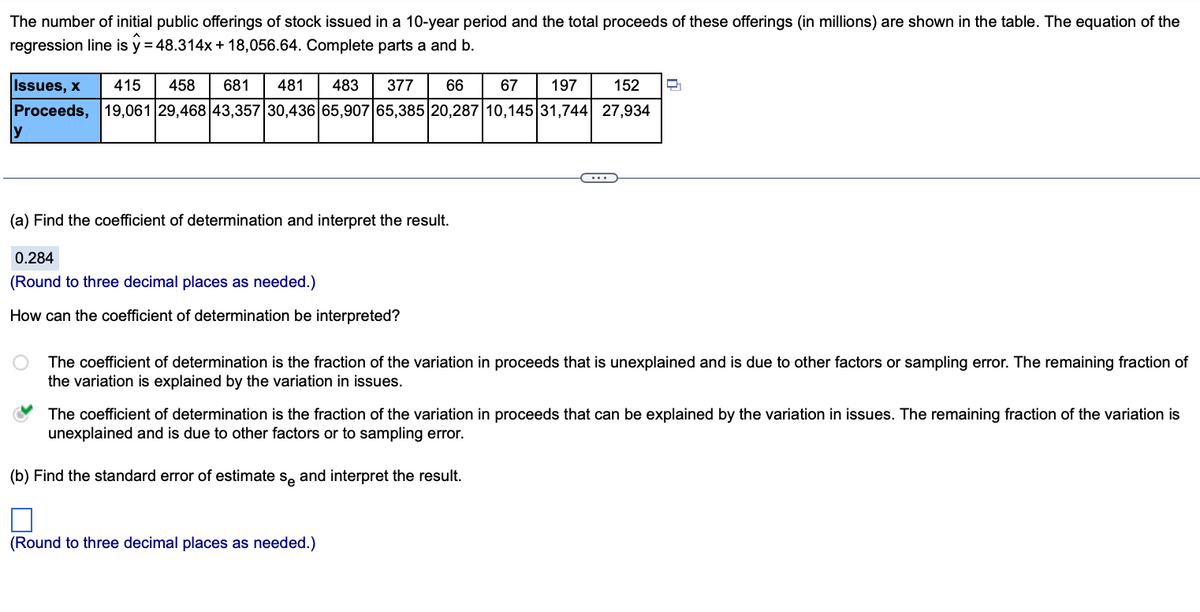The number of initial public offerings of stock issued in a 10-year period and the total proceeds of these offerings (in millions) are shown in the table. The equation of the regression line is y=48.314x+18,056.64. Complete parts a and b. Issues, x 415 458 681 481 483 377 66 67 197 152 Proceeds, 19,061 29,468 43,357 30,436 65,907 65,385 20,287 10,145 31,744 27,934 y (a) Find the coefficient of determination and interpret the result. 0.284 (Round to three decimal places as needed.) How can the coefficient of determination be interpreted? ….. O The coefficient of determination is the fraction of the variation in proceeds that is unexplained and is due to other factors or sampling error. The remaining fraction of the variation is explained by the variation in issues. The coefficient of determination is the fraction of the variation in proceeds that can be explained by the variation in issues. The remaining fraction of the variation is unexplained and is due to other factors or to sampling error. (b) Find the standard error of estimate se and interpret the result. (Round to three decimal places as needed.)
The number of initial public offerings of stock issued in a 10-year period and the total proceeds of these offerings (in millions) are shown in the table. The equation of the regression line is y=48.314x+18,056.64. Complete parts a and b. Issues, x 415 458 681 481 483 377 66 67 197 152 Proceeds, 19,061 29,468 43,357 30,436 65,907 65,385 20,287 10,145 31,744 27,934 y (a) Find the coefficient of determination and interpret the result. 0.284 (Round to three decimal places as needed.) How can the coefficient of determination be interpreted? ….. O The coefficient of determination is the fraction of the variation in proceeds that is unexplained and is due to other factors or sampling error. The remaining fraction of the variation is explained by the variation in issues. The coefficient of determination is the fraction of the variation in proceeds that can be explained by the variation in issues. The remaining fraction of the variation is unexplained and is due to other factors or to sampling error. (b) Find the standard error of estimate se and interpret the result. (Round to three decimal places as needed.)
Algebra & Trigonometry with Analytic Geometry
13th Edition
ISBN:9781133382119
Author:Swokowski
Publisher:Swokowski
Chapter7: Analytic Trigonometry
Section7.6: The Inverse Trigonometric Functions
Problem 94E
Related questions
Question

Transcribed Image Text:The number of initial public offerings of stock issued in a 10-year period and the total proceeds of these offerings (in millions) are shown in the table. The equation of the
regression line is y = 48.314x+18,056.64. Complete parts a and b.
67 197
152
Issues, x 415 458 681 481 483 377 66
Proceeds, 19,061 29,468 43,357 30,436 65,907 65,385 20,287 10,145 31,744 27,934
ly
(a) Find the coefficient of determination and interpret the result.
0.284
(Round to three decimal places as needed.)
How can the coefficient of determination be interpreted?
The coefficient of determination is the fraction of the variation in proceeds that is unexplained and is due to other factors or sampling error. The remaining fraction of
the variation is explained by the variation in issues.
The coefficient of determination is the fraction of the variation in proceeds that can be explained by the variation in issues. The remaining fraction of the variation is
unexplained and is due to other factors or to sampling error.
(b) Find the standard error of estimate se and interpret the result.
(Round to three decimal places as needed.)
Expert Solution
This question has been solved!
Explore an expertly crafted, step-by-step solution for a thorough understanding of key concepts.
Step by step
Solved in 4 steps with 7 images

Recommended textbooks for you

Algebra & Trigonometry with Analytic Geometry
Algebra
ISBN:
9781133382119
Author:
Swokowski
Publisher:
Cengage

Algebra & Trigonometry with Analytic Geometry
Algebra
ISBN:
9781133382119
Author:
Swokowski
Publisher:
Cengage